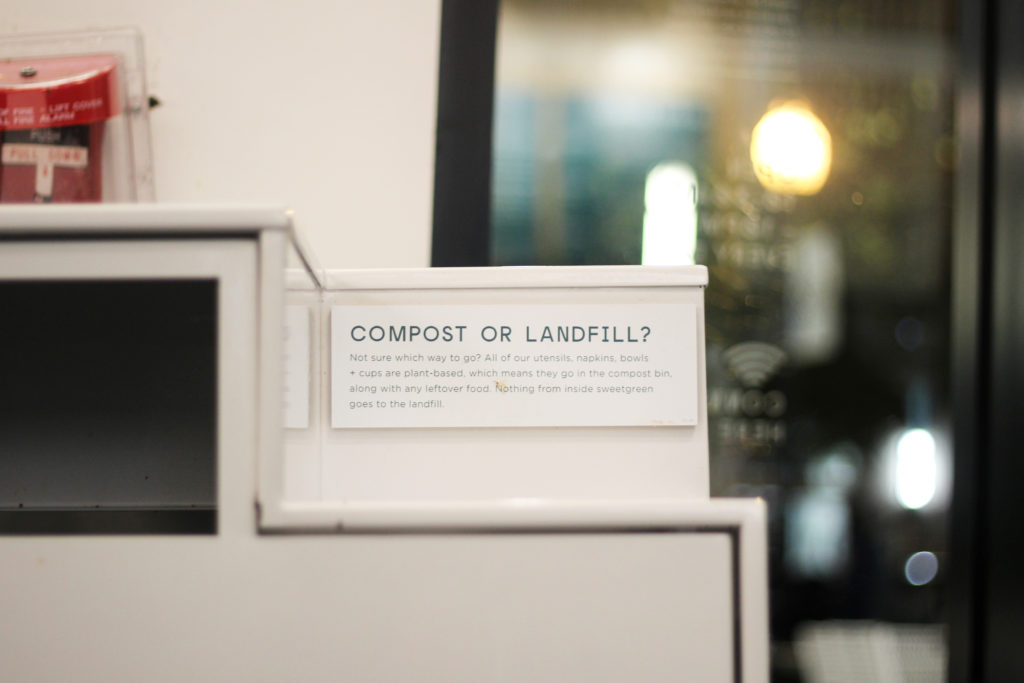Eight years after officials set a slew of sustainability goals for GW with deadlines for this calendar year, officials said they have taken steps to lower the University’s waste output and have promoted sustainable food consumption.
Officials had initially created targets in 2012 to work toward becoming a zero-waste campus, adding more green spaces and increasing the amount of locally grown food available on campus. Meghan Chapple, the director of the Office of Sustainability, said officials met GW’s goal to divert 40 percent of its waste from landfills by this calendar year and have added a water-absorbing space – Square 80 – to campus.
She said officials have adapted their goal to add more sustainable food to campus after officials switched to an open dining plan. She said GW still participated in its annual Green Move Out program, and students donated a total of 11,550 pounds of non-perishable items to charity.
“Sustainability is an issue area around which students, faculty and staff consistently are active,” Chapple said in an email.
She said officials designed the Square 80 space, which was constructed in 2010, using sustainable practices, like using pervious paving and collecting stormwater in the space. She said the fountain in Square 80 runs using collected stormwater.
She said the Law Learning Center, the Milken Institute School of Public Health, the Science and Engineering Hall and District House are all stormwater collecting spaces, with a collective capacity of almost 100,000 gallons.
Chapple said the University’s sustainability efforts ultimately save money, but she declined to say how much the initiatives cost.
She said moving forward, officials will focus the University’s sustainability efforts on divesting from fossil fuels, which the Board of Trustees voted in June to fully divest from by 2025 following pushes by student activists to divest from fossil fuels.
“Student activism has historically driven most major sustainability progress on campus, and we continue to hear from our stakeholders that they want GW to prioritize sustainability in and out of the classroom,” Chapple said.
Audrey Friedline, one of the GroW Garden managers, said she hopes the University will continue to prioritize sustainability even as the University’s budget tightens because of COVID-19.
“Due to COVID-19, cuts have already been made to sustainability initiatives,” Friedline said in an email. “However, this is the time when sustainability programs are needed most. There have been many faculty at GW that have fought for sustainability at all levels for many years, and the progress that has been made on these goals is because of their committed efforts.”
She said the University’s commitment to sustainability goes beyond funding green organizations on campus and should be focused on equity within the GW community.
“Sustainability is consciously paying attention to who is being employed, how workers are being paid, access students have to resources, how funds are being invested, how big the environmental footprint is and impact the University is making on the larger community, plus so much more,” she said.
Sustainability experts said universities must be transparent about their sustainability goals and continuously update their communities on their progress, even when they need to push a deadline or alter an objective.
The sustainability office released its first progress report in nearly a decade last February, which revealed that it had met just 14 of the University’s 56 sustainability goals set in 2009. Officials created the University’s Climate Action Plan in 2010 and provide information about sustainability initiatives on the sustainability office website.
Raul Lejano, a professor of environmental conservation education at New York University, said universities’ sustainability officials should organize teams to track data to report the institution’s progress annually, and officials should include shortcomings or changes in goals in their reports.
“We meet some goals, we exceed some goals, we miss some goals, but moving in the right direction and assessing where we are every year, saying ‘OK, we can do better here,’ that’s what’s needed,” he said.
Lejano said some sustainability efforts are quantifiable, but it can be harder to track changes in student culture and community engagement. He added that sustainability is rooted in compassion, which universities can sometimes overlook when formulating goals because they tend to focus on “technocratic” initiatives that are easy to advertise to prospective students.
“The heart of sustainability is care and compassion, and the sustainability goals normally don’t really reflect that,” he said.
Dennis Carlberg, the associate vice president for sustainability at Boston University, said becoming a zero-waste campus means reaching a 90 percent diversion rate for waste – that the majority of the campus’ waste is diverted from landfills – which he said is a “really, really” difficult goal.
“It has a lot to do with how you procure materials for your campus,” Carlberg said. “So procurement, reducing the waste that comes on campus to begin with, is a really critical job and then getting and ordering things that you can reuse as opposed to ordering things that get disposed of.”
Carlberg said using third parties, like the sustainability tracking systems STARS and LEED, to monitor universities’ sustainability efforts is key to staying on track to meet goals. He said updating community members on sustainability goals often, even if the institution hasn’t met a certain goal, is crucial to making progress.
“I tell everybody, ‘I don’t really care what the answers are, I just want the answers to be right,’” he said. “Because if we’re misleading ourselves thinking we’re doing better than we’re doing, then we really can’t address the problem very well.”








